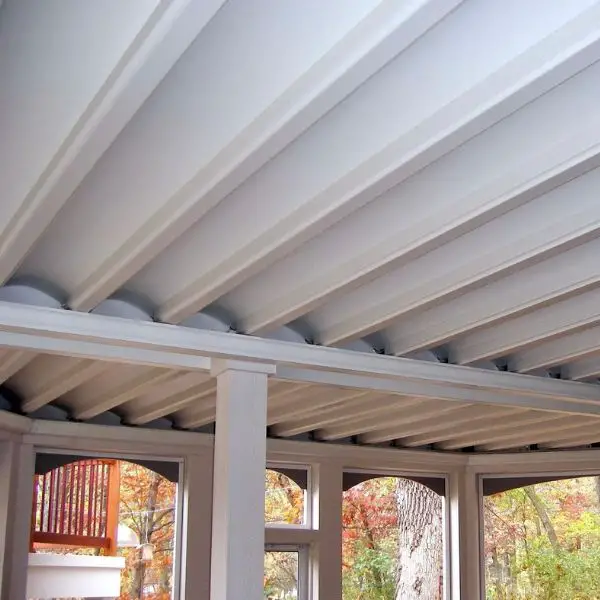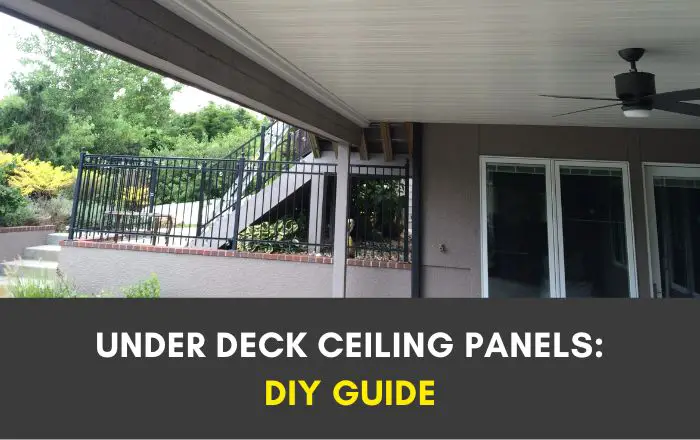If you don’t like seeing your deck wet after it rains, you might want to consider installing under-deck ceiling panels.
Not all of these panels are the same, though. You should look into different types before deciding, as some have more features than others.
The best materials for these panels are usually aluminum and vinyl. Installing under-deck ceiling panels helps make the space under your deck look neater and cooler.
It also helps protect the roof and improves the air quality around your house. Plus, you can put up lights and fans under your deck if you have these panels.
In this article, we’ll talk about the good and bad points of under-deck ceiling panels to help you figure out if they’re right for your home. Let’s dive in and learn more about them.
Different Types of Under Deck Ceiling Panels Materials
When you’re looking for materials for your under-deck ceiling, you have a lot of choices like aluminum, vinyl, and wood.
These ceilings can help control the temperature under your deck, making it cooler in summer and warmer in winter. It’s important to pick a material that’s long-lasting, looks good with your home, and is strong. Here’s a simple guide to the best materials:
Aluminum
Aluminum is a top choice for under-deck ceilings. It’s better than vinyl and wood because it doesn’t let water in and doesn’t rust or break down. You can find it in many colors to match your home’s style. These panels are light and easy to put up, plus they’re strong and don’t need much care.
Vinyl
Vinyl is a popular choice. It’s light, easy to install, and can be made in any color. Vinyl panels are budget-friendly and better than metal in some ways. It’s a strong material and good for the environment since you don’t need to paint or do much to maintain it.
Wood
Wood panels are a common choice because they look nice and you can paint or stain them to match your home.
They are affordable and easy to use but need some regular care like repainting or resealing to protect them from weather.
Steel
If you want something really durable, go for steel. Steel panels last a long time and can handle snow, ice, and rain. They also protect against fire. But, they can be expensive and may dent in bad weather.
Hardboard
Hardboard is made from wood fibers and resin. It’s cheaper than other materials but not as resistant to moisture and doesn’t last as long. Not great for very humid or rainy places.
Fiber Cement
Made from a mix of cement, sand, and cellulose fibers, fiber cement panels are very strong. They are great for places with pests because they don’t burn and are termite-resistant. They don’t need much care and don’t rot or crack. They can be painted easily, but they are one of the more expensive options.
Top Benefits of Installing an Under-Deck Ceiling

Turns Under-Deck into a Great Outdoor Space
An under-deck ceiling can make the space under your deck a nice place to hang out, have small parties, or even work from home. It covers up the beams underneath, making it easy to add lights.
It also protects the area from rain, snow, and direct sun, so you can put comfortable furniture and plants there, or use it as a dining area, entertainment spot, or outdoor office.
Increases Safety
The bottom of your deck can attract animals like squirrels and birds. The wood can also get damaged faster when it’s exposed to the weather.
An under-deck ceiling keeps this area safe from animals and weather damage, making the whole area look nicer and possibly increasing your home’s value.
Requires Less Maintenance
With a good under-deck ceiling, you won’t have to clean it as often. It’s easier to clean the ceiling panels than to remove things like spider webs or nests from open beams. Some systems are even simpler, where you just need to hose down the panels.
More Options to Enhance Your Home’s Look
A good-looking exterior can increase your home’s value. Adding a nice under-deck ceiling that matches your home’s style can really improve how it looks.
You can choose from different materials like wood, metal, or vinyl, and a professional can help you pick the best one for your house.
Reduces Water Damage
Your deck gets a lot of wear from the weather. Rainwater can soak into the ground and damage your deck’s structure over time. A good under-deck ceiling can work with a better drainage system to protect your deck from water damage.
How Much Does It Cost to Install an Under-Deck Ceiling?
Putting in an under-deck ceiling for a space that’s 14 by 20 feet could cost around $2,436 if you hire a professional, but doing it yourself might cost about $1,750.
Doing it yourself means you can save money and spend it on other parts of the project, like buying materials.
The total cost can change based on a few things. What materials you use, whether you add lights, how big the area is, and if you hire someone or do it yourself all affect the price.
If you decide to do the work yourself, you could save about 25% of the cost.
Ideas for Using Your Space Under an Elevated Deck
Outdoor Kitchen
You can set up a kitchen under your deck. It can be as simple as a rolling cart or as complete as a full kitchen. This way, you can enjoy meals outside no matter the weather, and if you add screens, you won’t have to worry about bugs.
Private Hideaway
Turn the space under your deck into your own secret spot. Add a big swing or a hammock. Put in some speakers for music. A small fountain and some plants or flowers can make it feel like a mini vacation spot.
Bar and Entertainment Area
Use the space under your deck for parties. Get a weatherproof TV for outdoor use. This will instantly make your parties better.
Imagine having a hot tub under your two-story deck. It can be your special place to relax on weekends.
If you like DIY projects, like woodworking or fixing things, the space under your deck is great for this. You’ll have extra room for your tools and projects.
Play Area
Make a fun area for the kids. You could put in a poker table, a cabinet with board games, or both. This covered outdoor space is perfect for family fun.
Storage Space
If you enclose the area under your deck, it can be a great storage place for garden tools, lawn mowers, or seasonal decorations.
Easy Steps to Install an Under-Deck Ceiling Panel

Planning Where to Put Purlins
First, figure out where to put the purlins (supports for your ceiling). Use a tape measure to mark every three feet at the bottom of the deck joists.
You’ll want a slight slope in your ceiling for drainage, about a quarter inch drop per foot. Check the slope along the whole deck with a level. Think about where you might want to put gutters, especially near beams.
Cutting the Purlins
Measure the distance across each joist where you made marks to know how long to cut your purlins. The first purlin should be three feet from your house.
Cut it to 3/4 inch by 1.5 inches using a table saw, then use a miter saw to cut it to the right length. Add 3/4 inch for every three feet and cut each piece to fit across your joists. Leave room for gutters at the end if you’re installing them.
Installing Purlins
Attach the purlins to the beams using 2-1/2-inch deck screws. If you’re using more than one piece of wood for each purlin, make sure they overlap at the middle of a joist.
Putting in the Ceiling Panels
Measure your deck to decide how many fiberglass panels you need. Attach the panels to the purlins with 1-inch screws that have washers to keep out moisture. Overlap each panel by one corrugation. If you need to trim a panel to fit, you can cut it with a saw.
Installing Gutters
If you’re adding gutters, make sure they have a slight slope towards where you want the water to go. The slope should be about half an inch for every ten feet. Attach gutter hangers every 24 inches along the beam.
Easy Care and Maintenance for Your Under-Deck Ceiling
Regular Sweeping
Keep the area under your deck clean with a simple sweep. To get rid of spider webs, dirt, or dust on the ceiling, just use a broom upside down.
Cleaning When Needed
If your ceiling panels start looking a bit dirty, you can clean them with a common household stain remover and degreaser.
Dish soap works well too. Just be careful with certain cleaners around plants and animals. Use a soft sponge, cloth, or old t-shirt to avoid scratching the panels.
Monthly Leaf Removal
If you have trees near your deck, leaves might build up in the drainage system. Blow or sweep leaves off the top deck once a month or as needed.
This helps prevent clogs. You could also use an outdoor rug on the top deck to catch most of the debris. If the drainage does get clogged, it might need to be cleaned out.
Power Washing
You can power wash the top deck and the metal panels below. Use a regular power washer with 1300 to 3000 PSI.
If you use a stronger one, it might push some water out through the drainage system, but it will dry up and go back to normal.
Material for Under-Deck Ceilings
The materials used for under-deck ceilings include vinyl, aluminum, steel, hardboard, fiber cement, and wood.
The most common materials are aluminum and steel. They’re great because they catch rainwater from the deck and channel it away into gutters.
Simple Guide to Under-Deck Ceilings and Protection
What’s the Name for the Ceiling Under a Deck?
The ceiling under a deck is often called an under-deck drainage system or soffits. It adds extra storage space to your home. This system helps keep water away from your house, increasing the value of your home by creating usable space. It also helps prevent mold and makes the area easier to clean.
Best Material for Under-Decking
The top choice for under-decking is ceiling panels. They let rain and snow drain away naturally, keeping your wooden deck dry. This helps prevent erosion and stops weeds, which can damage your deck by causing decay.
Stopping Rain Under Your Deck
To keep rain from getting under your deck, ceiling panels are the best option. Other ways to stop rain include installing a drainage system, laying down gravel, or using a waterproof membrane. A drainage system is a great alternative to ceiling panels as it guides water away from the deck’s structure.
What to Use to Cover Under Your Deck?
A watertight membrane is a good choice for covering under your deck. It stops rainwater and prevents damp areas where mold and weeds can grow, which could damage your deck. After installing a membrane, you’ll need to keep it clean to prevent dirt and debris build-up.
Final Thoughts
When picking the best material for your under-deck ceiling, think about a few things. First, look at the weather in your area.
If it’s often wet or humid, avoid wood because it can rot. Next, consider how you want your deck to look.
For a traditional style, wood or aluminum might be good. But for a modern look, vinyl or steel could be better.
Lastly, think about your budget. Aluminum and wood can be more expensive, while vinyl and hardboard are usually cheaper.
Hina Kanwal is the dynamic force behind Deckfaqs.com, blending her expertise in deck design with actionable insights. Known for her engaging content and practical advice, she empowers homeowners to elevate their outdoor spaces. Her passion and knowledge make her a trusted voice in the world of deck-building.







